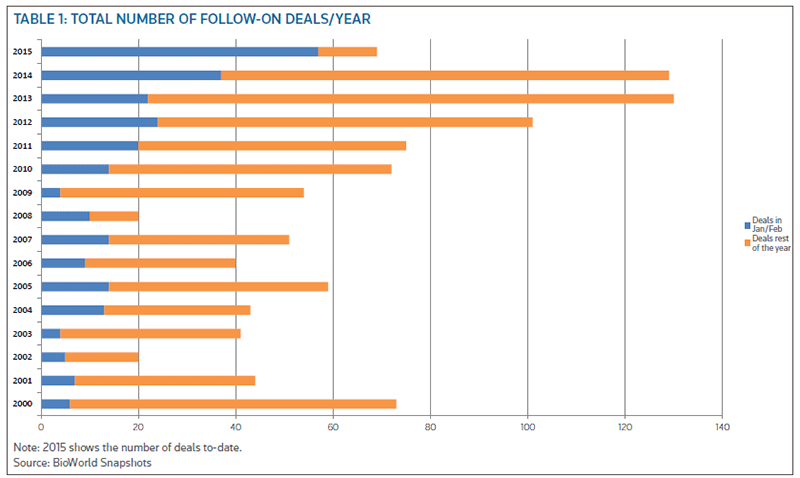In the fourth quarter of 2014 there were 30 public offering transactions generating approximately $6.4 billion, which was six times the amount raised through public offerings in the third quarter of 2014 from 17 deals.
Any thoughts that this torrid pace could not be maintained have been quickly dispelled with follow-on public offerings remaining on fire so far this year and already eclipsing the great fourth quarter of last year. According to data on the industry's financial transactions tracked by BioWorld Snapshots, the total of 57 deals completed in the first two months is way ahead of the number completed in any comparable period dating back to 2000. The closest was last year when 37 deals were completed in January and February. (See Table 1, below.)
In addition, the amount raised in this period is also off the charts at $6.25 billion.
As we approach the end of the first quarter the industry is on pace for approximately 80 public offerings completed in the three-month period. As of March 20, there have already been an additional 22 deals that have been completed, including Tekmira Pharmaceuticals Corp.'s $151.9 million offering priced Friday, generating a further $1 billion. Investor demand for those issuances continues to remain extremely high and there are no signs that the deal flow will slow down anytime soon.
TOP FIVE DEALS
The average amount raised per offering is approximately $100 million. The top five deals in terms of amount raised so far this quarter leads with San Rafael-based Biomarin Pharmaceutical Inc., which grossed about $911.5 million from a public offering of 8.5 million shares of common stock priced at $93.25 each. The final total also included the underwriters exercising in full their option to purchase an additional 1.275 million shares.
The company is using the net proceeds for general corporate purposes and to fund its acquisition of Prosensa Holding NV, announced last November and estimated to be worth about $680 million, with another $160 million to come for two near-term regulatory milestones. (See BioWorld Today, Nov. 25, 2014.)
Cambridge, Mass.-based Alnylam Pharmaceuticals Inc. padded its bank balance to the tune of $450 million, from an underwritten registered public offering of about 4.7 million shares of its common stock at a public offering price of $95 per share.
The rare diseases space continues to be hot (see Rare Disease Research and Development article in this issue.) Synageva Biopharma Corp. added proof of the investor enthusiasm in the space by completing a public offering of 3 million shares at $94.19 each to raise about $308 million. (See BioWorld Today, Jan. 8, 2015.)
The company reported top-line phase III data last year showing that sebelipase alfa (SBC-102), the enzyme replacement therapy for lysosomal acid lipase (LAL) deficiency, met its primary endpoint and several secondary endpoints. (See BioWorld Today, July 2, 2014).
It also recently submitted a biologics license application for LAL to the FDA, as well as a request for marketing clearance in Europe, for sebelipase alfa, to be branded Kanuma. With breakthrough designation in the U.S., the treatment could be approved in the third quarter of this year.
Neurocrine Biosciences Inc., a San Diego company developing drugs for neurological and endocrine disorders, raised $287 million in a public offering of about 7.96 million shares priced at $36 each to fund its growing roster of clinical trials.
Rounding out the top five deals is Puma Biotechnology Inc., which banked $211 million from its public offering of 1 million shares of common stock at $190 per share and another 150,000 shares sold by the underwriters exercising in full their overallotment option.
Continuing to fuel the current demand for follow-on financings is that "there are also more investors including generalists playing with much more cash in the market," notes John Chambers, head of health care investment banking at Roth Capital Partners. Those investors require significant positions to materially impact their fund's return profile. The broadening of the investor types running after biotech transactions is adding high octane fuel to valuations and raising demand for those offerings. (See BioWorld Insight, Jan. 26, 2015.)
POSITIVE ROI
Getting a good return on investment also helps, too. Investors participating in the offerings have seen their investments appreciate significantly. In fact, the collective public offering share prices had increased an average 27.6 percent by close of the market on Thursday.
For example, in February, Intercept Pharmaceuticals Inc., of New York, priced a public offering of 1.15 million shares at $176 each, generating $202 million to support its clinical, regulatory, medical affairs and commercial infrastructure ahead of the potential launch of its FDA breakthrough-designated nonalcoholic steatohepatitis therapy, obeticholic acid. Intercept's shares (NASADAQ:ICPT) closed up 64 percent on that issue price last Thursday at $288.51.
The other trades, which have worked quite well so far, are the follow-ons for last years' IPO class. The follow-on represents a "liquidity trade," Chambers said, in which investors "see not only the benefit to a company securing more capital – but also a positive benefit in stock price from an increasing liquidity profile."
The market for biotech public financings looks as though it will certainly remain strong for the foreseeable future given the prevailing investor sentiment.
Editor's Note: A full financial analysis of biotech's first quarter performance will be published in the April 6 issue.


